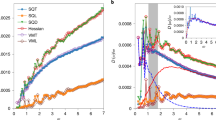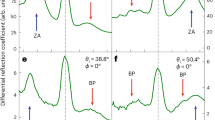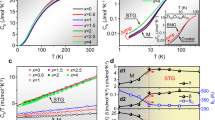Abstract
The physical properties of a topologically disordered amorphous material (glass), such as heat capacity and thermal conductivity, are markedly different from those of its ordered crystalline counterpart. The understanding of these phenomena is a notoriously complex problem. One of the universal features of disordered glasses is the ‘boson peak’, which is observed in neutron and Raman scattering experiments. The boson peak is typically ascribed to an excess density of vibrational states. Here, we study the nature of the boson peak, using numerical simulations of several glass-forming systems. We discovered evidence suggestive of the equality of the boson peak frequency to the Ioffe–Regel limit for ‘transverse’ phonons, above which transverse phonons no longer propagate. Our results indicate a possibility that the origin of the boson peak is transverse vibrational modes associated with defective soft structures in the disordered state. Furthermore, we suggest a possible link between slow structural relaxation and fast boson peak dynamics in glass-forming systems.
This is a preview of subscription content, access via your institution
Access options
Subscribe to this journal
Receive 12 print issues and online access
$259.00 per year
only $21.58 per issue
Buy this article
- Purchase on Springer Link
- Instant access to full article PDF
Prices may be subject to local taxes which are calculated during checkout





Similar content being viewed by others
References
Phillips, W. A. (ed.) Amorphous Solids: Low-Temperature Properties (Springer, 1981).
Frick, B. & Richter, D. The microscopic basis of the glass transition in polymers from neutron scattering studies. Science 267, 1939–1945 (1995).
Angell, C. A. Formation of glasses from liquids and biopolymers. Science 267, 633–636 (1995).
Greaves, G. N. & Sen, S. Inorganic glasses, glass-forming liquids and amorphizing solids. Adv. Phys. 56, 1–166 (2007).
Anderson, P. W. Through the glass lightly. Science 267, 1615–1616 (1995).
Debenedetti, P. G. & Stillinger, F. H. Supercooled liquids and the glass transition. Nature 410, 259–267 (2001).
Sokolov, A. P. et al. Low-temperature anomalies in strong and fragile glass formers. Phys. Rev. Lett. 78, 2405–2408 (1997).
Ioffe, A. F. & Regel, A. R. Non-crystalline, amorphous, and liquid electronic semiconductors. Prog. Semicond. 4, 237–291 (1960).
Rufflé, B., Guimbretière, G., Courtens, E., Vacher, R. & Monaco, G. Glass-specific behavior in the damping of acoustic-like vibrations. Phys. Rev. Lett. 96, 045502 (2006).
Scopigno, T., Suck, J.-B., Angelini, R., Albergamo, F. & Ruocco, G. High-frequency dynamics in metallic glasses. Phys. Rev. Lett. 96, 135501 (2006).
Ruocco, G., Matic, A., Scopigno, T. & Yannopoulos, S. N. Comment on Glass-specific behavior in the damping of acousticlike vibrations. Phys. Rev. Lett. 98, 079601 (2007).
Courtens, E., Foret, M., Rufflé, B. & Vacher, R. Comment on High-frequency dynamics in metallic glasses. Phys. Rev. Lett. 98, 079603 (2007).
Winterling, G. Very-low-frequency Raman scattering in vitreous silica. Phys. Rev. B 12, 2432–2440 (1975).
Nemanich, R. J. Low-frequency inelastic light scattering from chalcogenide glasses and alloys. Phys. Rev. B 16, 1655–1674 (1977).
Schober, H. R. Vibrations and relaxations in a soft sphere glass: Boson peak and structure factors. J. Phys. Condens. Matter 16, S2659–S2670 (2004).
Pilla, O. et al. The low energy excess of vibrational states in v-SiO2: The role of transverse dynamics. J. Phys. Condens. Matter 16, 8519–8530 (2004).
Horbach, J., Kob, W. & Binder, K. High frequency sound and the boson peak in amorphous silica. Eur. Phys. J. B 19, 531–543 (2001).
Dove, M. T. et al. Floppy modes in crystalline and amorphous silicates. Phys. Rev. Lett. 78, 1070–1073 (1997).
Hehlen, B. et al. Hyper-Raman scattering observation of the Boson peak in vitreous silica. Phys. Rev. Lett. 84, 5355–5358 (2000).
Rufflé, B., Parshin, D. A., Courtens, E. & Vacher, R. Boson peak and its relation to acoustic attenuation in glasses. Phys. Rev. Lett. 100, 015501 (2008).
Elliott, S. A unified model for the low-energy vibrational behaviour of amorphous solids. Europhys. Lett. 19, 201–206 (1992).
Klinger, M. I. Atomic quantum diffusion, tunnelling states and some related phenomena in condensed systems. Phys. Rep. 94, 184–312 (1983).
Klinger, M. I. & Kosevich, A. M. Soft-mode dynamics model of boson peak and high frequency sound in glasses: Inelastic Ioffe–Regel crossover and strong hybridization of excitations. Phys. Lett. 295, 311–317 (2002).
Buchenau, U. et al. Interaction of soft modes and sound waves in glasses. Phys. Rev. B 46, 2798–2808 (1992).
Duval, E., Boukenter, A. & Achibat, T. Vibrational dynamics and the structure of glasses. J. Phys. Condens. Matter 2, 10227–10234 (1990).
Götze, W. & Mayr, M. R. Evolution of vibrational excitations in glassy systems. Phys. Rev. E 61, 587–606 (2000).
Schirmacher, W., Diezemann, G. & Ganter, C. Harmonic vibrational excitations in disordered solids and the ‘boson peak’. Phys. Rev. Lett. 81, 136–139 (1998).
Schirmacher, W. Thermal conductivity of glassy materials and the “boson peak”. Europhys. Lett. 73, 892–898 (2006).
Schirmacher, W., Ruocco, G. & Scopigno, T. Acoustic attenuation in glasses and its relation with the Boson peak. Phys. Rev. Lett. 98, 025501 (2007).
Grigera, T., Martín-Mayor, V., Parisi, G. & Verrocchio, P. Phonon interpretation of the ‘boson peak’ in supercooled liquids. Nature 422, 289–292 (2003).
Lubchenko, V. & Wolynes, P. G. The origin of the boson peak and thermal conductivity plateau in low-temperature glasses. Proc. Natl Acad. Sci. USA 100, 1515–1518 (2003).
Wittmer, J. P., Tanguy, A., Barrat, J. L. & Lewis, L. Vibrations of amorphous, nanometric structures: When does continuum theory apply? Europhys. Lett. 57, 423–429 (2002).
Wyart, M., Nagel, S. R. & Witten, T. A. Geometric origin of excess low-frequency vibrational modes in weakly connected amorphous solids. Europhys. Lett. 72, 486–492 (2005).
Tanaka, H. Physical origin of the boson peak deduced from a two-order-parameter model of liquid. J. Phys. Soc. Jpn. 70, 1178–1181 (2001).
Andersen, H. C. Molecular dynamics studies of heterogeneous dynamics and dynamic crossover in supercooled atomic liquids. Proc. Natl Acad. Sci. USA 102, 6686–6691 (2005).
Shintani, H. & Tanaka, H. Frustration on the way to crystallization in glass. Nature Phys. 2, 200–206 (2006).
Tanaka, H. Two-order-parameter description of liquids. I. A general model of glass transition covering its strong to fragile limit. J. Chem. Phys. 111, 3163–3174 (1999).
Angell, C. A. et al. Potential energy, relaxation, vibrational dynamics and the boson peak, of hyperquenched glasses. J. Phys. Condens. Matter 15, S1051–S1068 (2003).
Scopigno, T., Ruocco, G., Sette, F. & Monaco, G. Is the fragility of a liquid embedded in the properties of its glass? Science 302, 849–852 (2003).
Ruocco, G. et al. Nondynamic origin of the high-frequency acoustic attenuation in glasses. Phys. Rev. Lett. 83, 5583–5586 (1999).
Taraskin, S. N. & Elliott, S. R. Low-frequency vibrational excitations in vitreous silica: The Ioffe–Regel limit. J. Phys. Condens. Matter 11, A219–A227 (1999).
Monaco, A. et al. Effect of densification on the density of vibrational states of glasses. Phys. Rev. Lett. 97, 135501 (2006).
Andrikopoulos, K. S., Christofilos, D., Kourouklis, G. A. & Yannopoulos, S. N. Pressure dependence of the Boson peak in glassy As2S3 studied by Raman scattering. J. Non-Cryst. Solids 352, 4594–4600 (2006).
Niss, K. et al. Influence of pressure on the Boson peak: Stronger than elastic medium transformation. Phys. Rev. Lett. 99, 055502 (2007).
Caponi, S., Fontana, A., Rossi, F., Baldi, G. & Fabiani, E. Effect of temperature on the vibrational density of states in vitreous SiO2: A Raman study. Phys. Rev. B 76, 092201 (2007).
Novikov, V. N., Ding, Y. & Sokolov, A. P. Correlation of fragility of supercooled liquids with elastic properties of glasses. Phys. Rev. E 71, 061501 (2005).
Bove, L. E., Petrillo, C., Fontana, A. & Sokolov, A. P. Damping of sound waves in the terahertz range and strength of the boson peak. J. Chem. Phys. 128, 184502 (2008).
Kawasaki, T., Araki, T. & Tanaka, H. Correlation between dynamic heterogeneity and medium-range order in two-dimensional glass-forming liquids. Phys. Rev. Lett. 99, 215701 (2007).
Acknowledgements
The authors are grateful to T. Kawasaki for his help in the Voronoi analysis and thank D. A. Head for a critical reading of the manuscript. This work was partially supported by a grand-in-aid from the Ministry of Education, Culture, Sports, Science and Technology, Japan.
Author information
Authors and Affiliations
Contributions
H.T. conceived the project, H.S. carried out numerical simulations and H.S. and H.T. made the analysis and wrote the paper.
Corresponding author
Supplementary information
Supplementary Information
Supplementary Information (PDF 269 kb)
Rights and permissions
About this article
Cite this article
Shintani, H., Tanaka, H. Universal link between the boson peak and transverse phonons in glass. Nature Mater 7, 870–877 (2008). https://doi.org/10.1038/nmat2293
Received:
Accepted:
Published:
Issue Date:
DOI: https://doi.org/10.1038/nmat2293
This article is cited by
-
Microscopic mechanisms of pressure-induced amorphous-amorphous transitions and crystallisation in silicon
Nature Communications (2024)
-
Low-frequency vibrational density of states of ordinary and ultra-stable glasses
Nature Communications (2024)
-
Resolving aging dynamics of a 3D colloidal glass
Science China Physics, Mechanics & Astronomy (2024)
-
Understanding the emergence of the boson peak in molecular glasses
Nature Communications (2023)
-
Observation of the boson peak in a two-dimensional material
Nature Physics (2023)



